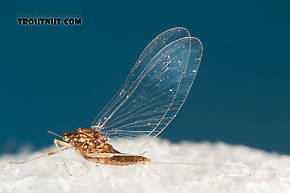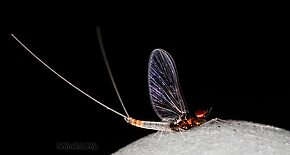Blog & Latest Updates
Fly Fishing Articles
Insects by Common Name


Tiny Blue-Winged Olives
Scientific Names
Like most common names, "Tiny Blue-Winged Olive" can refer to more than one taxon. They're previewed below, along with 6 specimens. For more detail click through to the scientific names.
Mayfly Genus Acentrella
These are pretty much always called Tiny Blue-Winged Olives.
The only Acentrella species commonly reported to be important to anglers is Acentrella turbida, though Acentrella insignificans is important in some western locales. See the species pages for distribution and timing details. This genus is one of two (including Heterocloeon) that can easily be distinguished from other Baetidae genera by the presence of a conical mesonotal projection (Conical mesonotal projection: small cone shaped spike sticking up from the top and front part of the middle thorax segment.). A. turbida lacks hindwings which is useful for distinguishing this species from all others in either genera. A. turbida was previously known by the names of its synonyms (Synonym: A former name of a taxon, usually a species. Entomologists frequently discover that two insects originally described as different species are one in the same, and they drop one of the names. The dropped name is said to be a synonym of the remaining name. These changes take a while to trickle into the common knowledge of anglers; for example, Baetis vagans is now a synonym of Baetis tricaudatus.) Pseudocloeon turbidum in the West and Pseudocloeon carolina in the East.
Male Acentrella insignificans (Tiny Blue-Winged Olive) Mayfly Nymph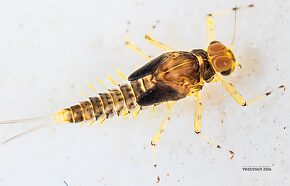 View 10 PicturesAnother nymph probably of the same species as this one emerged and was photographed as a dun and partly-molted spinner.
View 10 PicturesAnother nymph probably of the same species as this one emerged and was photographed as a dun and partly-molted spinner.
 View 10 PicturesAnother nymph probably of the same species as this one emerged and was photographed as a dun and partly-molted spinner.
View 10 PicturesAnother nymph probably of the same species as this one emerged and was photographed as a dun and partly-molted spinner.Female Acentrella (Tiny Blue-Winged Olives) Mayfly Dun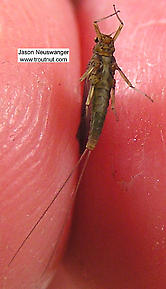 View 3 PicturesI've lost the date information for this specimen and taken a guess.
View 3 PicturesI've lost the date information for this specimen and taken a guess.
 View 3 PicturesI've lost the date information for this specimen and taken a guess.
View 3 PicturesI've lost the date information for this specimen and taken a guess.See 4 more specimens...
Mayfly Genus Acerpenna
These are pretty much always called Tiny Blue-Winged Olives.
See Acerpenna pygmaea for details. It is the only species known to be of even minor importance to anglers and was previously known as Baetis pygmaeus.
Acerpenna pygmaea (Tiny Blue-Winged Olive) Mayfly Nymph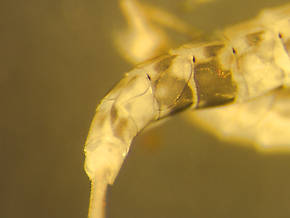 View 3 PicturesThis is a very rare mayfly in western Montana. The shape of the last gill is a key to its identification. I have collected this species in only one location.
View 3 PicturesThis is a very rare mayfly in western Montana. The shape of the last gill is a key to its identification. I have collected this species in only one location.
 View 3 PicturesThis is a very rare mayfly in western Montana. The shape of the last gill is a key to its identification. I have collected this species in only one location.
View 3 PicturesThis is a very rare mayfly in western Montana. The shape of the last gill is a key to its identification. I have collected this species in only one location.See 2 more specimens...
Mayfly Genus Apobaetis
These are pretty much always called Tiny Blue-Winged Olives.
This genus contains only one species of any known significance, Apobaetis futilis, a Western hatch. For anglers looking for correlation with older angler entomologies, this hind wingless little mayfly was formerly known as Pseudocloeon futile.
Mayfly Genus Heterocloeon
These are pretty much always called Tiny Blue-Winged Olives.
Heterocloeon is one of two genera along with Acentrella that can be differentiated from other baetids by the presence of a conical mesonotal projection (Conical mesonotal projection: small cone shaped spike sticking up from the top and front part of the middle thorax segment.). All but one species of this genus can be further separated from Acentrella by the lack of venation (Venation: The pattern in which the veins on the wings of an insect are arranged. It is usually one of the most useful identifying characteristics.) in the tiny hindwings. There is little evidence that the species of Heterocloeon are of much significance to anglers.
Mayfly Genus Iswaeon
These are pretty much always called Tiny Blue-Winged Olives.
This genus currently contains three species, only one of which is important to anglers. See Iswaeon anoka for details.
Mayfly Genus Labiobaetis
These are pretty much always called Tiny Blue-Winged Olives.
This genus contains only one species of interest to anglers, Labiobaetis propinquus. See the species hatch page for more information.
The species of this genus can be identified by the combination of its tiny elliptical hindwings lacking costal projections (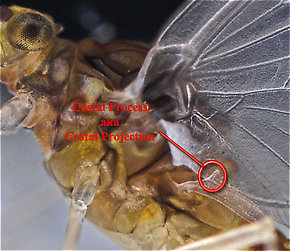 Costal projection: A bump or point sticking up from the front margin of an insect's wing, usually the rear wing of certain mayflies. It is sometimes called a costal process.) ( a few obscure species have them but they are so reduced as to be barely observable under low magnification) and lacking a conical mesonotal projection (Conical mesonotal projection: small cone shaped spike sticking up from the top and front part of the middle thorax segment.). Their two tailed nymphs are more difficult.
Costal projection: A bump or point sticking up from the front margin of an insect's wing, usually the rear wing of certain mayflies. It is sometimes called a costal process.) ( a few obscure species have them but they are so reduced as to be barely observable under low magnification) and lacking a conical mesonotal projection (Conical mesonotal projection: small cone shaped spike sticking up from the top and front part of the middle thorax segment.). Their two tailed nymphs are more difficult.
The species of this genus can be identified by the combination of its tiny elliptical hindwings lacking costal projections (

The costal projection of a Baetidae dun.
Mayfly Genus Plauditus
These are pretty much always called Tiny Blue-Winged Olives.
Two of the tiny species in this genus may produce fishable hatches: Plauditus dubius in the East and Midwest, and Plauditus punctiventris in the West. The latter is the most prolific and important. Both were previously in the genus Pseudocloeon.
Mayfly Genus Pseudocloeon
These are pretty much always called Tiny Blue-Winged Olives.
No information is presented here as all North American species previously assigned to this genus have been moved to other genera. For those working with older taxonomies, the following list of revisions will prove helpful. Click on the revised names to go to their respective hatch pages:
Pseudocloeon anoka = Iswaeon anoka
Pseudocloeon carolina = Acentrella turbida
Pseudocloeon dubium = Plauditus dubius
Pseudocloeon edmundsi = Iswaeon anoka
Pseudocloeon futile = Apobaetis futilis
Pseudocloeon Propinquum = Labiobaetis propinquus
Pseudocloeon punctiventris = Plauditus punctiventris
Pseudocloeon turbidum = Acentrella turbida
Pseudocloeon anoka = Iswaeon anoka
Pseudocloeon carolina = Acentrella turbida
Pseudocloeon dubium = Plauditus dubius
Pseudocloeon edmundsi = Iswaeon anoka
Pseudocloeon futile = Apobaetis futilis
Pseudocloeon Propinquum = Labiobaetis propinquus
Pseudocloeon punctiventris = Plauditus punctiventris
Pseudocloeon turbidum = Acentrella turbida
Mayfly Species Iswaeon anoka
These are pretty much always called Tiny Blue-Winged Olives.
This tiny hind-wingless Midwestern and Western species can produce excellent hatches because it is so extremely abundant. It appears in previous angling literature under the former names Pseudocloeon anoka in the Midwest and Pseudocloeon edmundsi for its western synonym (Synonym: A former name of a taxon, usually a species. Entomologists frequently discover that two insects originally described as different species are one in the same, and they drop one of the names. The dropped name is said to be a synonym of the remaining name. These changes take a while to trickle into the common knowledge of anglers; for example, Baetis vagans is now a synonym of Baetis tricaudatus.). Its bright green duns are unmistakable. In the West they can also be an equally unmistakable bright almost fluorescent chartreuse, especially as nymphs. They are very common in the Northwest and Rocky Mountain states, with their population densities giving way to the similarly tiny and hind-wingless (though more somber colored) Acentrella species in Southern Oregon, California and the Southwest.
Iswaeon anoka was first brought to the attention of the angling community (as Pseudocloeon anoka) by famous angling author and columnist Joe Brooks. Back in the late 60's he wrote an article for Outdoor Life magazine extolling the work of Doug Swisher and Carl Richards in their forthcoming and groundbreaking book, Selective Trout. This species was featured as the model for their now famous version of the "No-Hackle" dry fly and imitative parachute patterns, sparking a revolution in fly design for hyper-selective trout. The rest as they say, is history...
Iswaeon anoka was first brought to the attention of the angling community (as Pseudocloeon anoka) by famous angling author and columnist Joe Brooks. Back in the late 60's he wrote an article for Outdoor Life magazine extolling the work of Doug Swisher and Carl Richards in their forthcoming and groundbreaking book, Selective Trout. This species was featured as the model for their now famous version of the "No-Hackle" dry fly and imitative parachute patterns, sparking a revolution in fly design for hyper-selective trout. The rest as they say, is history...
Mayfly Species Plauditus dubius
These are pretty much always called Tiny Blue-Winged Olives.
This species may produce good hatches.
Mayfly Species Apobaetis futilis
These are pretty much always called Tiny Blue-Winged Olives.
This hind wingless little mayfly was formerly known as Pseudocloeon futile and can hatch in excellent numbers in certain western locales.
Mayfly Species Acentrella insignificans
These are pretty much always called Tiny Blue-Winged Olives.
This species shares its distribution with the much more common Acentrella turbida over much of it's range. In the West, it overshadows turbida in some locales. It can be differentiated from turbida by the presence of hind wings and from most other baetids by its hind wings having two longitudinal veins (Longitudinal vein: Longitudinal veins are the major long veins running length-wise through an insect's wing, connecting the base to the outer margin, or the major branches from those veins.) and a lack of costal projection ( Costal projection: A bump or point sticking up from the front margin of an insect's wing, usually the rear wing of certain mayflies. It is sometimes called a costal process.). It was previously classified as Baetis insignificans.
Costal projection: A bump or point sticking up from the front margin of an insect's wing, usually the rear wing of certain mayflies. It is sometimes called a costal process.). It was previously classified as Baetis insignificans.

The costal projection of a Baetidae dun.
Male Acentrella insignificans (Tiny Blue-Winged Olive) Mayfly Nymph View 10 PicturesAnother nymph probably of the same species as this one emerged and was photographed as a dun and partly-molted spinner.
View 10 PicturesAnother nymph probably of the same species as this one emerged and was photographed as a dun and partly-molted spinner.
 View 10 PicturesAnother nymph probably of the same species as this one emerged and was photographed as a dun and partly-molted spinner.
View 10 PicturesAnother nymph probably of the same species as this one emerged and was photographed as a dun and partly-molted spinner.Male Acentrella insignificans (Tiny Blue-Winged Olive) Mayfly Dun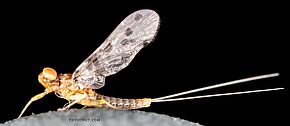 View 11 PicturesThis specimen emerged indoors from nymphs I had collected, then partly molted into a spinner but got stuck along the way. I've included a couple pictures showing some of the spinner colors. It got a bit waterlogged after emerging, so the wings aren't in perfect shape, but it still represents one of two Baetids that were emerging and drawing trout to rise on the Yakima. Based on body size and shape, it is most likely the same species as this nymph.
View 11 PicturesThis specimen emerged indoors from nymphs I had collected, then partly molted into a spinner but got stuck along the way. I've included a couple pictures showing some of the spinner colors. It got a bit waterlogged after emerging, so the wings aren't in perfect shape, but it still represents one of two Baetids that were emerging and drawing trout to rise on the Yakima. Based on body size and shape, it is most likely the same species as this nymph.
 View 11 PicturesThis specimen emerged indoors from nymphs I had collected, then partly molted into a spinner but got stuck along the way. I've included a couple pictures showing some of the spinner colors. It got a bit waterlogged after emerging, so the wings aren't in perfect shape, but it still represents one of two Baetids that were emerging and drawing trout to rise on the Yakima. Based on body size and shape, it is most likely the same species as this nymph.
View 11 PicturesThis specimen emerged indoors from nymphs I had collected, then partly molted into a spinner but got stuck along the way. I've included a couple pictures showing some of the spinner colors. It got a bit waterlogged after emerging, so the wings aren't in perfect shape, but it still represents one of two Baetids that were emerging and drawing trout to rise on the Yakima. Based on body size and shape, it is most likely the same species as this nymph.Mayfly Species Labiobaetis propinquus
These are pretty much always called Tiny Blue-Winged Olives.
This species was previously known as Baetis propinquus, a name from older nomenclatures and angling literature familiar to many western anglers. Prior to its current listing, it did a brief stint in the genus Pseudocloeon. The irony is that though this species has hind wings, it was the last species remaining in Pseudocloeon (before the genus recent Nearctic taxonomic demise) which was best known for its species lacking hind wings as an identifying character.
Though it has a national distribution its most important hatches occur in the West, usually hatching between the larger broods of Baetis tricaudatus. Western anglers experiencing a hatch can easily confuse them with the larger Baetis bicaudatus as both nymphs appear similar with only two tails. Besides size, the adults can be separated from bicaudatus (with the help of a little magnification) because L. propinquus lacks acute costal projections ( Costal projection: A bump or point sticking up from the front margin of an insect's wing, usually the rear wing of certain mayflies. It is sometimes called a costal process.) on its tiny hind wings. Conversely, the presence of hind wings and lack of conical mesonotal projections (Conical mesonotal projection: small cone shaped spike sticking up from the top and front part of the middle thorax segment.) makes them easy to tell from the more common and equally tiny Acentrella turbida.
Costal projection: A bump or point sticking up from the front margin of an insect's wing, usually the rear wing of certain mayflies. It is sometimes called a costal process.) on its tiny hind wings. Conversely, the presence of hind wings and lack of conical mesonotal projections (Conical mesonotal projection: small cone shaped spike sticking up from the top and front part of the middle thorax segment.) makes them easy to tell from the more common and equally tiny Acentrella turbida.
Though it has a national distribution its most important hatches occur in the West, usually hatching between the larger broods of Baetis tricaudatus. Western anglers experiencing a hatch can easily confuse them with the larger Baetis bicaudatus as both nymphs appear similar with only two tails. Besides size, the adults can be separated from bicaudatus (with the help of a little magnification) because L. propinquus lacks acute costal projections (

The costal projection of a Baetidae dun.
Mayfly Species Acerpenna pygmaea
These are pretty much always called Tiny Blue-Winged Olives.
This species is known in older taxonomies under the former name Baetis pygmaeus.
It is a diminutive baetid with distribution across every region. It is reported to have localized hatches of occasional importance.
It is a diminutive baetid with distribution across every region. It is reported to have localized hatches of occasional importance.
Acerpenna pygmaea (Tiny Blue-Winged Olive) Mayfly Nymph View 3 PicturesThis is a very rare mayfly in western Montana. The shape of the last gill is a key to its identification. I have collected this species in only one location.
View 3 PicturesThis is a very rare mayfly in western Montana. The shape of the last gill is a key to its identification. I have collected this species in only one location.
 View 3 PicturesThis is a very rare mayfly in western Montana. The shape of the last gill is a key to its identification. I have collected this species in only one location.
View 3 PicturesThis is a very rare mayfly in western Montana. The shape of the last gill is a key to its identification. I have collected this species in only one location.See 2 more specimens...
Mayfly Species Acentrella turbida
These are pretty much always called Tiny Blue-Winged Olives.
These tiny mayflies were once known by the names Pseudocloeon carolina in the East and Pseudocloeon turbidum in the West. They are now considered synonymous. With the new species name turbida, these mayflies were also moved to the genus Acentrella. The combining of these two species has made turbida's distribution trans-continental. In places their numbers compensate for their small size and make for excellent hatches.
In the West, turbida is more variable in size and appearance than its eastern iteration, in keeping with the large and varied regions it inhabits. It can run as small as 3.5 mm and as large as 5 mm, the larger sizes tending to be more brownish. It is often confused with the smaller broods of Diphetor hageni, but its conical mesonotal projection (Conical mesonotal projection: small cone shaped spike sticking up from the top and front part of the middle thorax segment.), lack of hind-wings, exaggerated turbinate (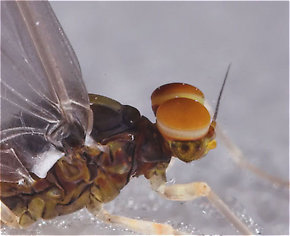 Turbinate: Shaped like a top or elevated on a stalk; usually refers to the eyes of some adult male Baetidae mayflies which are wider near the tip than at the base.) eyes (hence its name) and stockier build help to differentiate it.
Turbinate: Shaped like a top or elevated on a stalk; usually refers to the eyes of some adult male Baetidae mayflies which are wider near the tip than at the base.) eyes (hence its name) and stockier build help to differentiate it.
They are often found on the water with a mix of other Baetidae mayflies, making for very challenging fishing.
In the West, turbida is more variable in size and appearance than its eastern iteration, in keeping with the large and varied regions it inhabits. It can run as small as 3.5 mm and as large as 5 mm, the larger sizes tending to be more brownish. It is often confused with the smaller broods of Diphetor hageni, but its conical mesonotal projection (Conical mesonotal projection: small cone shaped spike sticking up from the top and front part of the middle thorax segment.), lack of hind-wings, exaggerated turbinate (

This male Baetidae dun has slightly turbinate eyes.
They are often found on the water with a mix of other Baetidae mayflies, making for very challenging fishing.
See 3 more specimens...
Mayfly Species Baetis intercalaris
These are often called Tiny Blue-Winged Olives.
Mayfly Species Plauditus punctiventris
These are very rarely called Tiny Blue-Winged Olives.
This species produces very strong hatches on fertile Western spring creeks. They are extremely small mayflies but may be extremely numerous.
Top 10 Fly Hatches
Top Gift Shop Designs
Eat mayflies.
Top Insect Specimens
Miscellaneous Sites
Troutnut.com is copyright © 2004-2024 Jason
Neuswanger (email Jason). See my FAQ for information about use of my images.
 privacy policy
privacy policy

